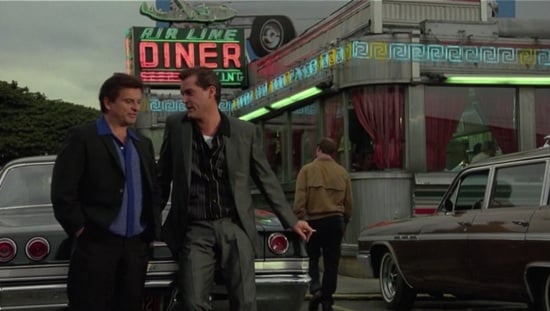Shocking Blocking (13)
By:
January 22, 2011
Singling out one scene from Goodfellas, which eschews traditional narrative structure and instead requires viewers to infer the film’s meaning on a scene-by-scene basis, is a sucker’s game. Each scene ingeniously contributes to Martin Scorsese’s vision of an idler’s dystopia: a Big Rock Candy Mountain, located in Brooklyn in the Fifties (1954-63), where they took the jerk who invented work out into the alley and put a bullet in his head. However, the brief and wordless scene [above], set at the Airline Diner (supposedly near Idlewild Airport; it’s actually near La Guardia) in 1963, is worth mentioning because it’s one of the few in which we see Henry Hill (Ray Liotta) and Tommy DeVito (Joe Pesci) at work in broad daylight. As the blocking suggests, Henry and Tommy don’t distinguish between work and leisure: as a result, they’re deeply engaged, and enjoying themselves. Any scholar who studies this topic will tell you that this is what idleness is about. Though Scorsese, who postponed Goodfellas to make a movie about one of history’s greatest idlers (Jesus), doesn’t rationalize crime and violence, he does sympathize with these two idle-wilds. Who refuse to live, as Hill puts it in the film’s coda, like “schnooks”: i.e., non-idlers.
An occasional series analyzing some of the author’s favorite moments in the positioning or movement of actors in a movie.
THIRTIES (1934–1943): It Happened One Night (1934) | The Man Who Knew Too Much (1934) | The Guv’nor (1935) | The 39 Steps (1935) | Young and Innocent (1937) | The Lady Vanishes (1938) | Mr. Smith Goes to Washington (1939) | The Big Sleep (1939) | The Little Princess (1939) | Gone With the Wind (1939) | His Girl Friday (1940)
FORTIES (1944–1953): The Diary of a Chambermaid (1946) | The Asphalt Jungle (1950) | The African Queen (1951)
FIFTIES (1954–1963): A Bucket of Blood (1959) | Beach Party (1963)
SIXTIES (1964–1973): For Those Who Think Young (1964) | Thunderball (1965) | Clambake (1967) | Bonnie and Clyde (1967) | Madigan (1968) | Wild in the Streets (1968) | Barbarella (1968) | Harold and Maude (1971) | The Mack (1973) | The Long Goodbye (1973)
SEVENTIES (1974–1983): Les Valseuses (1974) | Eraserhead (1976) | The Bad News Bears (1976) | Breaking Away (1979) | Rock’n’Roll High School (1979) | Escape from Alcatraz (1979) | Apocalypse Now (1979) | Caddyshack (1980) | Stripes (1981) | Blade Runner (1982) | Tender Mercies (1983) | Monty Python’s The Meaning of Life (1983)
EIGHTIES (1984–1993): Repo Man (1984) | Buckaroo Banzai (1984) | Raising Arizona (1987) | RoboCop (1987) | Goodfellas (1990) | Candyman (1992) | Dazed and Confused (1993) |
NINETIES (1994–2003): Pulp Fiction (1994) | The Fifth Element (1997)
OUGHTS (2004–13): Nacho Libre (2006) | District 9 (2009)
READ MORE essays by Joshua Glenn, originally published in: THE BAFFLER | BOSTON GLOBE IDEAS | BRAINIAC | CABINET | FEED | HERMENAUT | HILOBROW | HILOBROW: GENERATIONS | HILOBROW: RADIUM AGE SCIENCE FICTION | HILOBROW: SHOCKING BLOCKING | THE IDLER | IO9 | N+1 | NEW YORK TIMES BOOK REVIEW | SEMIONAUT | SLATE
Joshua Glenn’s books include UNBORED: THE ESSENTIAL FIELD GUIDE TO SERIOUS FUN (with Elizabeth Foy Larsen); and SIGNIFICANT OBJECTS: 100 EXTRAORDINARY STORIES ABOUT ORDINARY THINGS (with Rob Walker).

